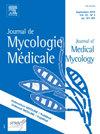成人头癣:突尼斯中部一项14年回顾性研究。
IF 1.8
4区 医学
Q3 MYCOLOGY
引用次数: 0
摘要
目的:头癣(TC)是一种常见的真菌感染,主要影响学龄儿童,而在成人中罕见。很少有研究,特别是在突尼斯,专门关注成人的TC。本回顾性研究旨在评估突尼斯中部(北非)成人TC的流行病学和真菌学特征。方法:对突尼斯苏塞Farhat Hached大学医院诊断的成人TC病例进行回顾性研究,研究时间长达14年(2009-2022年)。诊断依据临床表现和真菌学培养。在接受检查的3711名患者中,41名成年患者(24名女性和17名男性)被诊断为TC。平均年龄为43岁。10例患者有皮质类固醇治疗史。体格检查发现6例(14.6%)伴有体癣,10例(24%)伴有甲真菌病,1例(2.4%)伴有这两种情况。直接检查阳性率为97.5%。最常见的种是紫毛霉(Trichophyton violaceum)和犬小孢子菌(Microsporum canis)(34%)。在大多数情况下,治疗过程是有利的。结论:我们强调TC在成人中是一种罕见的疾病,在女性,特别是绝经后妇女中观察到较高的患病率。成人TC虽然不常见,但由于其潜在的非典型表现,应在老年患者头皮病变的鉴别诊断中予以考虑。紫毛蝗是突尼斯中部最常见的种类。准确的真菌学诊断和确定致病因素仍然至关重要。本文章由计算机程序翻译,如有差异,请以英文原文为准。
Tinea capitis in adults: A 14-year retrospective study in central Tunisia
Objectives
Tinea capitis (TC) is a common fungal infection predominantly affecting school-aged children while being rare among adults. Few studies, particularly in Tunisia, have specifically focused on TC in adults. This retrospective study aimed to assess the epidemiological and mycological profile of adult TC in central Tunisia (North Africa).
Methods
A retrospective study of adult TC cases diagnosed at the Farhat Hached University Hospital of Sousse, in Tunisia, has been carried out over a 14-year period (2009–2022). Diagnosis was based on clinical presentation and mycological culture. Of 3711 patients examined, 41 adult patients (24 women and 17 men) were diagnosed with TC. The mean age was 43 years old. Ten patients had a history of corticosteroid therapy. Physical examination revealed associated tinea corporis in 6 cases (14.6 %), onychomycosis in 10 cases (24 %) and both those conditions concomitantly in one patient (2.4 %). Direct examination was positive in 97.5 % of cases. The most prevalent species of dermatophyte were Trichophyton violaceum (46 %) and Microsporum canis (34 %). In the majority of cases, the course of treatment was favorable.
Conclusion
We highlight TC as an uncommon condition in adults, with a higher prevalence observed in women, particularly postmenopausal women. Adult TC, though uncommon, should be considered in differential diagnoses for scalp lesions in elderly patients due to potential atypical presentations. Trichophyton violaceum is the most frequent species in central Tunisia. Accurate mycological diagnosis and identification of contributing factors remain crucial.
求助全文
通过发布文献求助,成功后即可免费获取论文全文。
去求助
来源期刊
CiteScore
5.10
自引率
2.80%
发文量
68
审稿时长
6-12 weeks
期刊介绍:
The Journal de Mycologie Medicale / Journal of Medical Mycology (JMM) publishes in English works dealing with human and animal mycology. The subjects treated are focused in particular on clinical, diagnostic, epidemiological, immunological, medical, pathological, preventive or therapeutic aspects of mycoses. Also covered are basic aspects linked primarily with morphology (electronic and photonic microscopy), physiology, biochemistry, cellular and molecular biology, immunochemistry, genetics, taxonomy or phylogeny of pathogenic or opportunistic fungi and actinomycetes in humans or animals. Studies of natural products showing inhibitory activity against pathogenic fungi cannot be considered without chemical characterization and identification of the compounds responsible for the inhibitory activity.
JMM publishes (guest) editorials, original articles, reviews (and minireviews), case reports, technical notes, letters to the editor and information. Only clinical cases with real originality (new species, new clinical present action, new geographical localization, etc.), and fully documented (identification methods, results, etc.), will be considered.
Under no circumstances does the journal guarantee publication before the editorial board makes its final decision.
The journal is indexed in the main international databases and is accessible worldwide through the ScienceDirect and ClinicalKey platforms.

 求助内容:
求助内容: 应助结果提醒方式:
应助结果提醒方式:


